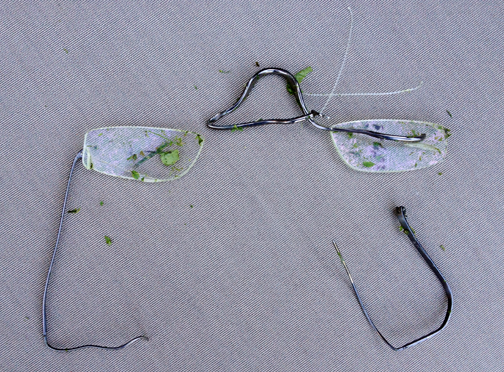|
Let me answer your questions. How does it work? It works like a loop, where you simply hang your glasses on it, except the back part gently holds the temple piece in the closed position. So your glasses don't flop open, fall out, and get run over by the lawn mower (see image below). If your glasses do get bumped, however, the dynamic three-dimensional shape is designed to catch them by the temple piece and keep them from falling to the ground. This is a product of the intersection of curved surfaces, leveraging inertia and gravity to hook and clamp your glasses by their own weight. It gets pretty nerdy to explain it further. How do you envision it produced? For the baseline version, injection molding makes sense, for scale and economy. Other variations may require different methods, such as metal casting. But aluminum molding could work. How much will it cost to produce? For a solo operator like me, who has to dig up suppliers from the phone book and pay their mark-up, the amortized price (assuming full life of the mold tool) is less than 15 cents per plastic injection-molded unit, plus neck cord and packaging. In-house production would reduce that. Nicer materials--plexiglas, tortoise shell, stone, metal, leather-and-brass--would run higher. What kind of neck cord does it require? Any. You can put it on a gold chain, an elastic silicon cord, a nylon string with clasp, beaded leather, or whatever suits your fancy. Or price point. Does it come in only one size? No. The current, standard version has been sized to hold the most popular promotional (RayBan knock-off) sunglasses. But the design is easily scalable to accommodate larger or smaller glasses, if necessary.
Are there any exciting possibilities you haven’t mentioned yet? Did I mention the version that doubles as a bottle opener—ideal for beach or barbecue? But wait—there’s more. The physical shape of the back surface can be expanded, sculpted and molded to incorporate logos, decorative graphics, and even theme park character shapes that give park-goers something to keep their glasses safe on a roller coaster (yes, I’ve tested that) and then a useful souvenir (ka-ching!) to take home. Is it patented? Yes. The Shark Tooth™ has been awarded two Utility Patents and one Design Patent (U.S. Patent Nos. 10,537,166, 10,835,022; U.S. Design Patent No. D796,196). Hang on, it gets better. The way it looks is directly related to the way it works. So, once it’s on the market, its trade dress will provide IP exclusivity long after the patents expire. What about the name? My wife thought of it. I like it. But your marketing department should have the final say. I can explain to my wife. Who are you? I am a national award-winning cartoonist, best known for my work in The New Yorker. I am also an illustrator and author, who used to be an advertising copywriter and, before that, an aerospace engineer. Plus I co-founded The Drawing Board, a cartoonist-led business training consultancy for DEI, ESG, team building, and brainstorming. Can we see a prototype sample? Absolutely. Just say the word. Reach me at pat@patbyrnes.com or 773-472-3649. |
|||||

